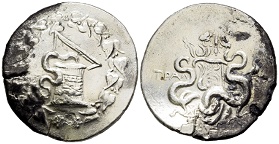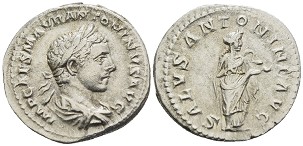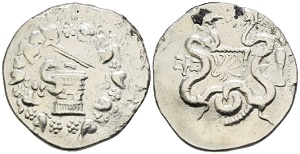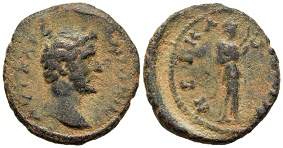Fine Coins Showcase
Antiquities Showcase
Hide empty categories
Shop Search
Shopping Cart
My FORVM
Contact Us
About Forum
Shopping at Forum
Our Guarantee
Payment Options
Shipping Options & Fees
Privacy & Security
Forum Staff
Selling Your Coins
Identifying Your Coin
FAQs
zoom.asp
Home ▸ Catalog ▸ |Themes & Provenance| ▸ |Animals| ▸ |Snake||View Options:   | | | | | | The Greeks and Romans did not view snakes as evil creatures but rather as symbols and tools for healing and fertility. Asclepius, the son of Apollo and Koronis, learned the secrets of keeping death at bay after observing one serpent bringing another healing herbs. Woman seeking fertility, the sick, and the injured slept in his temples in chambers where non-poisonous snakes were left to crawl on the floor and provide healing.
|


On the slopes of Mount Messogis in the valley of the Meander, Tralles, was one of the largest and richest cities of Lydia. King Attalus had a splendid palace there. The local god was Zeus Larasios, but Apollo Pythius and other divinities were also worshiped. Tralles was destroyed by an earthquake but was rebuilt by Augustus and took the name of Caesarea.
The cista mystica was a basket used for housing sacred snakes in connection with the initiation ceremony into the cult of Bacchus (Dionysus). In the Dionysian mysteries a snake, representing the god and possibly symbolic of his phallus, was carried in a cista mystica on a bed of vine leaves.
From pages 73-74 of Kleiner-Noe: "In Series 40, the chief and subsidiary symbols are eagle and fulmen respectively, both attributes of Zeus Larasius and commonly used on the coinage of Tralles; the monogram [...] must refer to the official who also signs as ΔΙΟΓΕ." The "must" was undoubtedly added here by Kleiner on account of the fact that the obverse die used in striking our coin was also paired with at least one of the ΔΙΟΓΕ marked reverses. A rare confirmation of a rather complex Greek monogram!GS114887. Silver cistophoric tetradrachm, Kleiner-Noe Series 40 (17 spec.; obv. die 72); SNG Cop 650; SNGvA 3256; SNG Fitzwilliam VI 4898; SNG Berry II 1146; BMC Lydia p. 329, 28, VF, flan cracks, partly covered in thick black tarnish on one side (hoard patina?), surfaces otherwise lightly toned and smooth, weight 11.445 g, maximum diameter 29.3 mm, die axis 0o, Tralleis (Aydýn, Turkey) mint, c. 140 - 135 B.C., magistrate Dioge(nes?); obverse snake emerging from a cista mystica with half-open lid, all within ivy wreath; reverse two coiling snakes, heads erect, around bow in ornamented bow-case, vertical fulmen above center, TPAΛ (Tralleis) horizontal at center left, eagle standing right at center right, ΔIOΓE monogram (magistrate) low inner left; $200.00 (€188.00)
Elagabalus, 16 May 218 - 11 March 222 A.D.


The reverse refers to Elagabalus' health, perhaps indicating that with the help of Salus he had recovered from an illness.RS115098. Silver denarius, RIC IV 140, RSC III 256, BMCRE V 28, SRCV II 7543, Hunter III -, Choice VF, excellent portrait, well centered on a broad flan, flow lines, weight 3.144 g, maximum diameter 19.5 mm, die axis 180o, Rome mint, 218 - 219 A.D.; obverse IMP CAES M AVR ANTONINVS AVG, laureate, draped, and cuirassed bust right, seen from behind; reverse SALVS ANTONINI AVG, Salus standing half right, diademed head right, with right hand feeding snake held in left; from the estate of Curtis D. Barker, ex Littleton Coin Company; $180.00 (€169.20)
Ephesos, Ionia, Cistophoric Coinage Under Attalid Rule, c. 160 - 150 B.C.


In his 1979 ANSMN article, "Some Reflections on the Early Cistophoric Coinage," which was a critique of the 1977 Kleiner-Noe monograph, Otto Mørkholm writes: "The old notion that Ephesus was the most important cistophoric mint and that the coinage originated there are shown to be wrong. It was only after 134/3 B.C. that Ephesus became the most prolific cistophoric mint. The huge production of the years 134/3 to 129/8 B.C., demanding 45 obverse dies in six years, was undoubtedly a result of Ephesus' position as a military headquarters in the fighting against Aristonicus."GS114886. Silver cistophoric tetradrachm, Kleiner-Noe Series 13 (13 spec.); SNG Cop. 305; SNGvA 1852; BMC Ionia, p. 63, 143, Pinder 19, aVF, lightly toned, decent centering, and smooth surfaces with two small spots of horn silver on rev., weight 11.338 g, maximum diameter 28.6 mm, die axis 0o, Ephesos (near Selcuk, Turkey) mint, c. 160 - 150 B.C.; obverse snake emerging from a cista mystica with half-open lid, all within ivy wreath; reverse bow in ornamented bow-case between two coiling snakes, heads erect, ΕΦΕ horizontal on center left, cult statue of Artemis Ephesia standing facing on center right; $150.00 (€141.00)
Antoninus Pius, August 138 - 7 March 161 A.D., Nicaea, Bithynia


Nicaea remained an important town throughout the imperial period. Although only 70 km (43 miles) from Constantinople, Nicaea did not lose its importance when Constantinople became the capital of the Eastern Empire. The city suffered from earthquakes in 358, 362 and 368; after the last of which, it was restored by Valens. During the Middle Ages, it was a long time bulwark of the Byzantine emperors against the Turks.RP113281. Bronze AE 17, apparently unpublished variant; RIC IV.1 T5889 var. (obv. leg.); SNG Cop 474 (same); Rec Gén 95.2, pl. LXIX.2 (rev. only) (same), VF, rev. off centered, porosity, light marks, clay-rich sediments, weight 3.752 g, maximum diameter 19.5 mm, Nicaea (Iznik, Turkey) mint, 138 - 161 A.D.; obverse AVT KAIC ANTΩNINO-C, Bare head right; reverse NEIKA-IEΩN, Hygieia standing right, feeding serpent in her arms from patera in right hand; extremely rare; $110.00 (€103.40)
Nero, 13 October 54 - 9 June 68 A.D., Side, Pamphylia


Side was founded by Greeks from Cyme, Aeolis, most likely in the 7th century B.C. The settlers started using the local language and over time forgot their native Greek. Excavations have revealed inscriptions written in this language, still undeciphered, dating from as late as the 2nd century B.C. The name Side is from this indigenous Anatolian language and means pomegranate.RP113732. Bronze AE 19, RPC Online I 3404 (4 spec.), BMC Lycia p. 53, 75; SNGvA 4810; cf. SNG Cop 414 (younger portrait), aVF, dark patina, highlighting earthen deposits, scratch behind eye, weight 4.576 g, maximum diameter 19.1 mm, die axis 45o, Side (near Selimiye, Antalya Province, Turkey) mint, c. 65 A.D.; obverse NEPΩN KAICAP, draped, bare-headed bust right; reverse CIΔ-HT, Athena advancing left, spear and pomegranate in right, shield in left, snake before at feet; scarce; $110.00 (€103.40)
Valerian I, October 253 - c. June 260 A.D., Cotiaeum, Phrygia


Asklepios is the Greek god of medicine. Hygieia is the goddess of health and Asklepios' daughter. Telesphoros is Asklepios' assistant. Asklepios learned the secrets of keeping death at bay after observing one snake bringing another snake healing herbs. Woman seeking fertility, the sick, and the injured slept in his temples in chambers where non-poisonous snakes were left to crawl on the floor and provide healing.RP110209. Bronze tetrassarion, SNG Hunt 2048; SNG Mu 333 var. (rev. leg.); SNG Cop 337 var. (same) BMC Phrygia p. 177, 94 var. (bust); SNGvA 3791 var. (Telesphoros in center), VF, dark near black patina, light deposits, near centered, die wear, small rev. die crack/breaks, weight 7.089 g, maximum diameter 25.1 mm, die axis 195o, Cotiaeum (Kutahya, Turkey) mint, Oct 253 - c. Jun 260 A.D.; obverse AVT K Π ΛIK OVAΛEPIANON, radiate, draped, and cuirassed bust right, seen from behind; reverse EΠ Π AIΛ ΔHMHETPIANOY IΠ (P. Ailios Demetrios hipparchos, HM ligate), Hygieia, on left, standing right, feeding serpent in right hand from patera in left hand; Asklepios, on right, standing facing, head left, leaning with right hand on serpent-entwined staff; AP/X (archon) in two lines above center, KOTIAEΩN (ΩN ligate) in exergue; $100.00 (€94.00)
Caracalla, 28 January 198 - 8 April 217 A.D., Nicopolis ad Istrum, Moesia Inferior


Nicopolis ad Istrum was founded by Trajan around 101 - 106, at the junction of the Iatrus (Yantra) and the Rositsa rivers, in memory of his victory over the Dacians. Its ruins are located at the village of Nikyup, 20 km north of Veliko Tarnovo in northern Bulgaria. The town reached its peak during the reigns of Trajan, Hadrian, the Antonines and the Severan dynasty.RP113338. Bronze assarion, H-H-J Nikopolis 8.18.47.19 (R3), AMNG I/I 1506, Varbanov I 3002 (R4) var. (obv. leg.), VF, dark patina, broad flan with full legends, edge ragged, weight 3.188 g, maximum diameter 18.1 mm, die axis 45o, Nicopolis ad Istrum (Nikyup, Bulgaria) mint, as caesar, 196 - 198 A.D.; obverse M AV KAI ANTONINOC, bare head right; reverse NIKOΠOΛ ΠPOC IC, tall narrow vase (or torch?) entwined by snake, fluted and ringed, stalks of grain hanging down on each side; ex Barry Murphy (Sep 2007); zero sales of this type recorded on Coin Archives in the last two decades; $90.00 (€84.60)
Valerian I, October 253 - c. June 260 A.D., Isinda, Pisidia


Isinda stood in a strategic position at the western end of the pass leading from Pamphylia by Termessus to Pisidia. The coinage of Isinda indicates the city considered itself an Ionian colony.RP97734. Bronze assarion, SNG BnF 1622; SNG Pfalz 234; BMC Lycia p. 227, 21; SNG Hunterian -; SNGvA -; SNG Cop -, aVF, dark brown patina, weight 8.444 g, maximum diameter 24.3 mm, die axis 180o, Isinda (Kisla, Turkey) mint, Oct 253 - c. Jun 260 A.D.; obverse AK ΠΛ OVAΛEPIANON CEB, laureate, draped, and cuirassed bust right, seen from behind; reverse ICIN-Δ-EΩN, mother goddess seated right on a high backed throne, holding swaddled infant on her lap, coiled serpent rising up before her; ex Numismatica Ars Classica Auction 100 (29 May 2017), lot 1320; $80.00 (€75.20)
Syracuse, Sicily, Roman Rule, 212 - c. 189 B.C.


Overcoming formidable resistance and the ingenious devices of Archimedes, the Roman General Marcus Claudius Marcellus took Syracuse in the summer of 212 B.C. Archimedes was killed during the attack. The plundered artworks taken back to Rome from Syracuse lit the initial spark of Greek influence on Roman culture.GI114972. Bronze AE 12, Calciatti II 223, SNG Cop 908, SNG München 1494, HGC 2 1529 (R1), SNG ANS -, F, green patina, earthen deposits, weight 1.772 g, maximum diameter 12.2 mm, die axis 0o, Syracuse mint, 212 - c. 189 B.C.; obverse bearded and laureate head of Asklepios right; reverse ΣYPAKOΣIΩN, serpent coiled around a staff; ex Classical Numismatic Group mail bid 78 (14 May 2008), lot 124, (part of); first example of this type handled by FORVM; scarce; $80.00 (€75.20)
Valerian I, October 253 - c. June 260 A.D., Isinda, Pisidia


Isinda stood in a strategic position at the western end of the pass leading from Pamphylia by Termessus to Pisidia. The coinage of Isinda indicates the city considered itself an Ionian colony.RP110212. Bronze assarion, SNG BnF 1622; VA Pisidiens 940; SNG Pfalz 234; BMC Lycia p. 227, 21; SNG Hunterian -; SNGvA -; SNG Cop -, Choice aVF, well centered, green patina, light earthen deposits, reverse struck a little flat, weight 10.475 g, maximum diameter 25.8 mm, die axis 180o, Isinda (Kisla, Turkey) mint, Oct 253 - c. Jun 260 A.D.; obverse AK ΠΛ OVAΛEPIANON - CEB, laureate, draped, and cuirassed bust right, seen from behind; reverse ICIN-Δ-EΩN, mother goddess seated right on a high backed throne, holding swaddled infant on her lap, coiled serpent rising up before her; $70.00 (€65.80)
CLICK HERE TO SEE MORE FROM THIS CATEGORY - FORVM's PRIOR SALES



Page created in 1.266 seconds.








